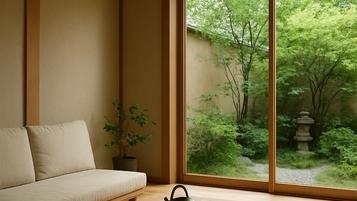A mindful home is not merely a place to live — it is a conscious space, where every line, material, and beam of light is born from awareness and understanding.
Mindful design does not chase trends; it returns to the natural essence of life — where matter and energy, form and Qi, body and mind become one.
1. Matter – The physical form of living space

Every home begins with matter: wood, stone, earth, water, light, and wind.
Matter is the “body” of the home — what people interact with through their senses every day.
In mindful design, materials are not chosen merely for beauty or durability, but for the energy they carry.
Wood has warmth and fragrance that relax the nervous system.
Stone conveys groundedness and the stability of the earth.
Natural light is rhythm — regulating the human biological clock.
Wind and humidity are breath — keeping the space alive and flexible.
When materials are used with a calm and conscious heart, they become living matter — an extension of the human being.
2. Space – Where energy breathes

A mindful home always breathes.
Space is not emptiness but a subtle energy field in motion.
Every current of wind, ray of light, silence, and sound affects the emotional frequency of the inhabitants.
In Japanese architecture, this living void is called “Ma (間)” — the vital space between things.
“Ma” is not just an absence, but a place where energy flows, where one can sense their own presence in stillness.
A beautiful home is not necessarily one that is comfortable to live in.
Only when emptiness is respected, light softened, sound gentled, and air allowed to circulate naturally — then the home truly lives.
3. Mind – The source energy that shapes space

Space reflects the minds of those who design and dwell within it.
If the architect creates from a restless, hurried mind, the space will carry that same unease.
If the resident focuses only on appearance, neglecting breath and stillness, the home becomes soulless.
Mindful design begins from clarity and understanding — where every choice of light, material, color, or layout is made with awareness and goodwill.
When the mind is calm, space naturally becomes transparent, harmonious, and gentle.
That is when matter transforms into energy, and the home becomes a “Dharma body” — the second body of its inhabitants.
4. From form to Qi – From outer to inner

A mindful home does not seek to display, but to express profound simplicity:
Reduce unnecessary materials → the space breathes.
Simplify excessive details → the mind feels light.
Increase natural light and openness → energy flows freely.
When the form is simplified, Qi — life energy — begins to reveal itself.
Warmth emanates not from machines but from the natural balance between matter and spirit.
5. The home as a spiritual practice

Living in a mindful home is itself a form of meditation.
Each morning when we open the windows, wipe the wooden floor, or water the plants — these are meditative acts.
When we live fully in each motion, our energy merges with the home’s energy.
“The home is a mirror reflecting the consciousness of its inhabitant.”
“When we are still, the home is still. When we are at peace, the home radiates light.”
🌿 Conclusion
Designing a mindful home is the art of harmony — between science and meditation, between matter and energy, between human and nature.
It is not about perfection, but about returning everything to its natural order — where people can live, breathe, and simply be themselves.
Tags
Related news

10 Innovative Ways to Use IAQ Data for Healthy Buildings
Closing the Gap Between Data and Action For forward-thinking organizations, improving Indoor Air Quality (IAQ) is a strategic priority. IAQ...
View detail
Body – Mind – Qi: The Foundation of Healing Architecture
The home is not only a shelter for the body but also a space that nurtures the soul and life...
View detail
Why Do Modern Homes Make Us Tired?
1. Disconnection from Nature – Loss of Biological Rhythm Modern homes are often sealed: small windows, reflective glass, constant air...
View detail





